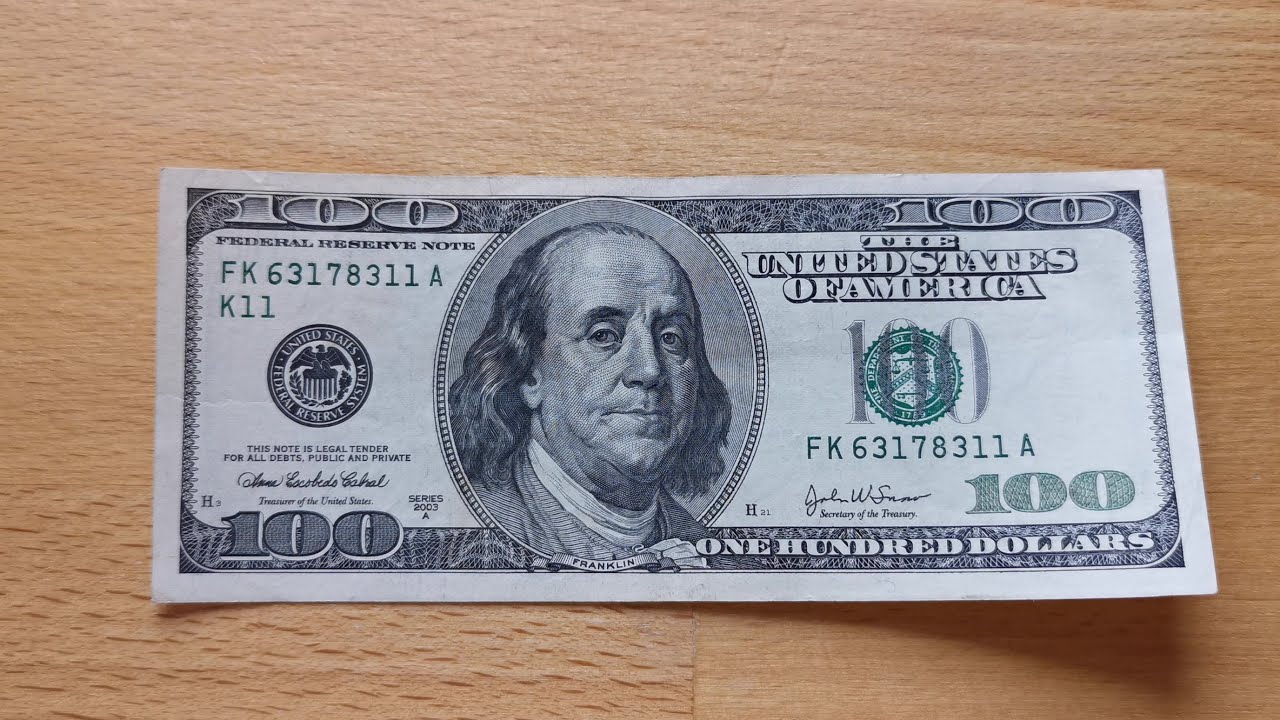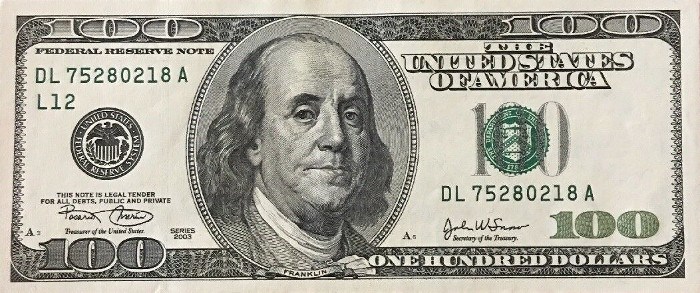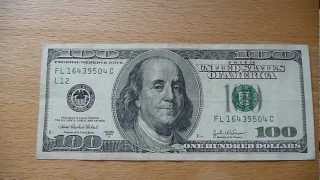The 2003 100 dollar bill is a part of the United States currency, and like many collectible bills, its value can fluctuate depending on various factors. While the face value of the bill remains $100, collectors and enthusiasts often seek out specific characteristics that may increase its worth.
This article will provide a thorough examination of the 2003 $100 bill value, along with additional insights into its collectible aspects such as series, errors, star notes, and more.
Understanding The 2003 100 Dollar Bill
The 2003 $100 bill features the portrait of Benjamin Franklin, one of the most well-known figures in American history. The bill is part of the 2003 series and is available in both the 2003 and 2003A series, with small but important differences in their characteristics.
One of the key distinguishing features of these bills is the presence of certain security features that make them harder to counterfeit.

The primary denomination is $100, which is commonly referred to as the one hundred dollar bill or 100 dollar bill.
Specifications of the 2003 $100 Bill
- Denomination: $100.00 USD
- Portrait: Benjamin Franklin
- Series: 2003, 2003A
- Security Features: Watermark, security thread, microprinting, color-shifting ink
- Material: Cotton-linen blend paper
The value of these bills in terms of face value is $100, but collectors often look beyond this to determine the true worth of a particular $100 bill. For most 2003 $100 bills, unless in pristine or uncirculated condition, they hold little more than their face value.
However, certain factors can affect their overall value in the collector’s market, such as errors, rarity, and series variations.
Factors Affecting the 2003 $100 Bill Value
Several elements can influence the value of a 2003 $100 bill, and understanding these factors is essential for determining its true worth. Some of the most common considerations include the condition of the bill, whether it is a star note, if there are any printing errors, and the overall rarity of the note.
1. Condition of the Bill
One of the most significant factors affecting the value of any paper money, including the 2003 $100 bill, is its condition. Bills in pristine, uncirculated condition are worth more than those that have been in circulation and show signs of wear and tear. The grading system used to assess the condition of bills is crucial.
A bill in uncirculated condition, such as an MS 63 grade, will typically fetch a premium in the collector’s market.
- Uncirculated Condition (MS 63): In this condition, a bill shows no signs of ever having been in circulation. It retains its crispness, with no folds, tears, or creases. The paper remains fresh, and the ink is intact. Uncirculated 2003 $100 bills may be worth around $125.
- Circulated Bills: Bills that have been in circulation, especially those with visible wear such as folds, dirt, or faded ink, are typically worth their face value of $100.
2. Star Notes
A star note is a type of replacement note that the U.S. Federal Reserve prints when a bill is damaged during the printing process. These star notes are more rare than regular bills, and collectors often place a higher value on them due to their rarity.
You can easily identify a star note by looking for a star symbol at the end of the serial number.
The 2003 series $100 star notes can be particularly valuable:
- 2003 Series Star Notes: These notes are worth between $265 and $275 in uncirculated condition with an MS 63 grade. The rarity of star notes makes them highly desirable among collectors, and they often command prices much higher than their face value.
- 2003A Series Star Notes: The 2003A series star notes are generally valued around $175 in uncirculated condition with a similar grade. Though these are worth a little less than the 2003 series star notes, they are still considered valuable collectibles.
3. Errors and Variations
Errors on bills are another factor that can significantly increase the value of a 2003 $100 bill. These errors can occur during the printing process and may include misprints, off-center printing, or mismatched serial numbers.
Because these errors are unintentional and rare, they can be highly sought after by collectors, making them more valuable than standard bills.

Common printing errors include:
- Misaligned printing: When the design or serial number is printed off-center.
- Inverted serial numbers: If the serial numbers appear upside down or are incorrectly printed.
- Serial number discrepancies: Sometimes, multiple bills can share the same serial number, which is a mistake.
The presence of these errors can significantly raise the worth of a bill in the collector’s market, depending on the severity of the error and the rarity.
The 2003 $100 Bill Grading System
The condition of a bill is critical in determining its value, and the grading system is the standard used to evaluate the bill’s overall quality.
The most commonly used grading scale is the Numerical Grading System, which ranges from 1 to 70, with 70 being the highest grade.
- MS 63 (Choice Uncirculated): A bill that shows no signs of wear and maintains its original crispness and freshness.
- AU (About Uncirculated): A bill with minimal wear and slight signs of circulation.
- VF (Very Fine): A bill that shows moderate wear, but the design is still visible, and the bill retains its overall shape.
- F (Fine): A bill that shows significant wear, creases, and folds but is still legible.
- VG (Very Good): A bill that has heavy wear, but it still retains its overall structure and design.
A higher-grade bill, especially one graded at MS 63 or above, will typically sell for a premium price. This is particularly true for rare bills, such as star notes or those with printing errors, which are more likely to be found in uncirculated or excellent condition.
Is the 2003 $100 Bill Rare?
Unless a 2003 $100 bill has some distinguishing feature like an error or is a star note, it is not considered rare. The 2003 series was printed in large quantities, meaning most 100 dollar bills from this series are not particularly valuable. However, certain factors can affect the rarity of individual bills:
Star notes are relatively rare compared to regular bills.
Errors that occurred during printing can make a bill more rare.
Uncirculated bills are less common than those that have been in circulation, and thus, they hold more value.
For most collectors, the key to finding a valuable 2003 $100 bill lies in identifying these rarer variations and ensuring that the bill remains in excellent condition.
How to Verify a 2003 $100 Bill
It’s important to know how to verify that a 2003 $100 bill is genuine. Counterfeit bills are common, so it’s crucial to examine the security features of the bill carefully.
Here are a few tips for determining if a 2003 $100 bill is real:
- Watermark: Hold the bill to the light, and you should see a watermark of Benjamin Franklin.
- Security Thread: This vertical thread runs to the left of Franklin’s portrait. It’s embedded into the paper and is imprinted with the letters “USA” and the numeral “100.”
- UV Light: When placed under ultraviolet light, the security thread should glow pink.
- Color-shifting Ink: The numeral “100” in the lower right corner will shift from copper to green when tilted.
These security features are designed to prevent counterfeiting and help you confirm the authenticity of your bill.
Conclusion: What is the 2003 $100 Bill Worth?
The 2003 100 dollar bill value generally remains at face value unless it is in uncirculated condition or features specific characteristics such as being a star note or having printing errors. While most bills from the 2003 and 2003A series are not particularly valuable in themselves, they can command higher prices if they are in pristine condition or possess rare qualities like a star note or printing error.
If you have a 2003 $100 bill in excellent condition or suspect it may be a rare find, it could be worth much more than $100. Be sure to check for features such as the star note symbol, any noticeable printing errors, and the overall condition of the bill to determine its true worth. Whether you are a seasoned collector or a casual enthusiast, understanding the value of the 2003 100 dollar bill can help you make informed decisions about your paper money collection.

